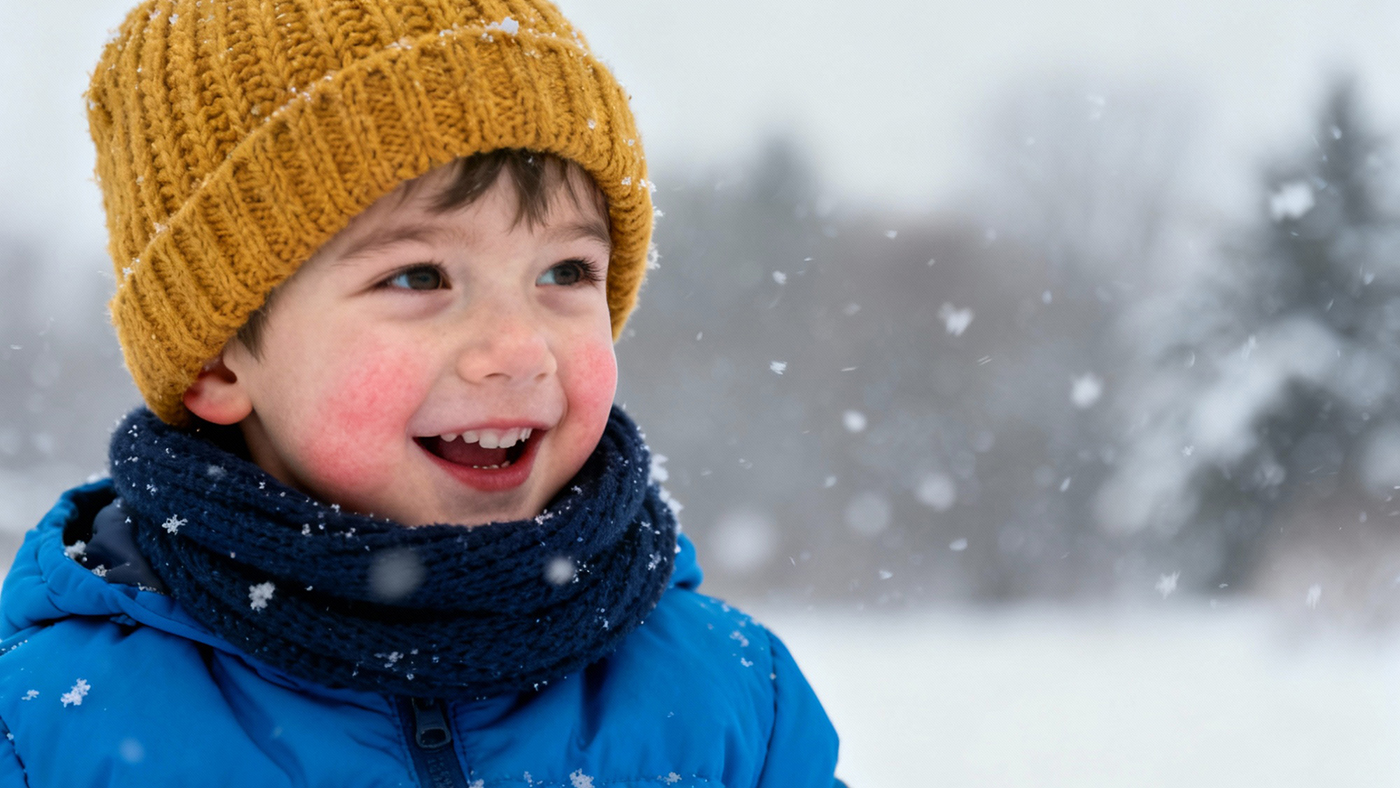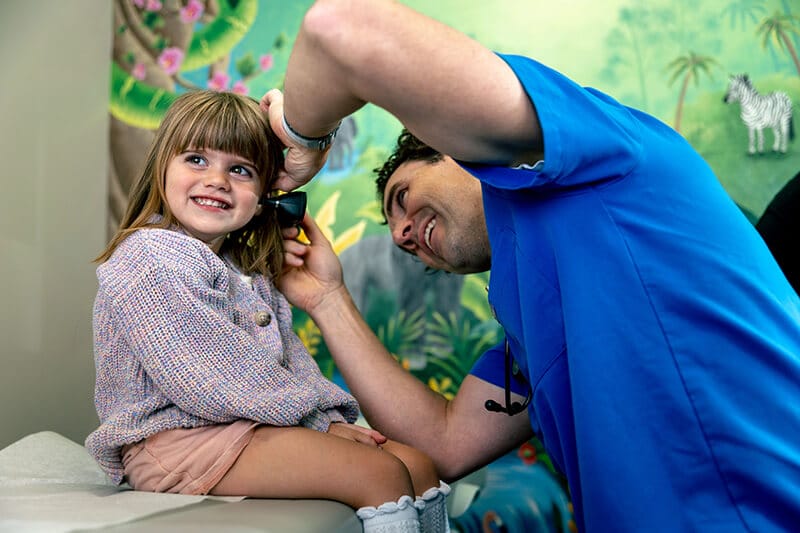From sledding down powdery hills to building snowmen and enjoying crisp mountain air, Utah’s cold, snowy winters bring endless opportunities for outdoor adventure. But while the fun in the snow is a highlight of the season, the cold, dry air can be harsh on skin.
Eczema in kids, commonly known as atopic eczema or childhood atopic dermatitis, usually causes patches of red, dry, sore skin. During a flare-up, eczema can be so itchy that kids scratch uncontrollably, especially at night.
Eczema is the most common chronic skin disorder in children, impacting between 10 and 20 percent of kids. Of those children, about 65 percent show signs in the first year of life, and 90 percent show symptoms before their fifth birthday. Most of the time, eczema is manageable and often resolves on its own as children get older. Still, it can be unpleasant and can even lead to secondary infections if left untreated.
If your child is experiencing patches of itchy, irritated skin caused by eczema, or if you’re preparing for winter flare-ups, here’s everything you need to know!
What causes eczema?
While the precise cause or causes of eczema aren’t wholly understood, many kids and adults experience dry skin during winter as the drop in humidity and exposure to chilly winds strip the skin of moisture. Eczema is an inflammatory, allergic, and non-contagious skin disorder that may be caused by the immune system overreacting to irritants, allergens, and other triggers. Anyone can get eczema, but it’s more common in families that have a history of allergies, asthma, and eczema, and the cold, dry air can exacerbate it.
Eczema weakens the skin barrier, which helps your skin retain moisture and protects your body from the outside world. Eczema disrupts the skin barrier, triggering an immune response and leading to the characteristic itching and redness.
While the underlying skin disorder is the same, eczema presents differently across demographics. Those with darker skin tones may have purple, brown, or gray patches, while those with lighter skin tones may have pink, red, or purple patches. The good news is that about half of all kids outgrow eczema over time, and for the rest, it is highly manageable.
What does eczema look like?
The symptoms and severity of eczema vary from person to person, but there are some commonalities. Patches of inflammation often appear on the face, trunk, and extremities in children, and you may see eczema on the buttocks of a toddler. In teens and adults, atopic dermatitis tends to appear in the creases of the arms and the back of the legs.
Patches feature raw and sensitive skin. The skin may be scaly, bumpy, red, and/or swollen. If left untreated or if scratching is chronic, the skin can become thickened and hardened. Eczema isn’t usually painful, but it can cause pain and bleeding if the skin gets broken. Breaks happen from scratching irritated areas or from the skin drying out and cracking.
Eczema often comes and goes, flaring up periodically before subsiding again. A flare-up can make it difficult for your child to enjoy daily activities, and the discomfort can make it difficult to sleep. Moreover, nighttime itching can lead to skin infections and scarring.
What causes eczema flare-ups?
While you can’t prevent your child from developing eczema, you can avoid triggers that can cause flare-ups.
- Food allergens: About a third of all people with eczema also have a food allergy to nuts, dairy, seafood, etc. In addition to the danger of an allergic reaction, exposure to food allergens is associated with eczema flare-ups.
- Environmental allergens: Pollen, dust mites, pet dander, and other environmental allergens can worsen eczema symptoms.
- Cleaners: Certain cleaners commonly cause skin irritation. When shopping for soaps, cleaners, and laundry detergents, look for something free of irritants and scents.
- Dry air: Eczema disrupts the skin barrier, reducing your skin’s ability to retain moisture, and it makes eczema worse. Adding a humidifier to your child’s room, especially with Utah’s dry winter air, can be helpful.
- Rapid temperature changes: Extreme temperature shifts can trigger a flare, for example, going from being outside in the snow to sitting in front of a fireplace.
If your child is experiencing eczema symptoms or skin flare-ups, your pediatric provider can diagnose eczema by examining your child’s skin and reviewing their medical history. In most cases, a physical exam and questions about symptoms are enough to confirm the diagnosis. However, if a child’s eczema is severe, unusual, or not responding to treatment, your pediatric provider may recommend additional testing to identify possible triggers. This can include allergy testing to check for environmental or food allergies that may worsen eczema.
Eczema Treatment for Kids
Eczema can’t be cured, but it can be managed with over-the-counter and prescription treatment.
Symptoms and appropriate treatments vary from person to person. Some people can manage with commercially available moisturizers, while others might need individualized treatment plans to keep flare-ups under control. It’s enough to leave you wondering what the best hydrocortisone cream for eczema is or if your child needs a prescription ointment for eczema.
Eczema treatments for kids include over-the-counter moisturizers, such as Cetaphil or Eucerin, topical hydrocortisone (any brand will do), and prescription moisturizers designed to relieve eczema symptoms. They are specially formulated to soothe the itch associated with eczema, improve skin hydration, and provide a protective barrier for irritated skin. Help young children practice applying emollients until they get the hang of it themselves.
If your child’s eczema changes appearance or gets dramatically worse, contact your pediatric provider for help. For moderate or severe eczema, treatment may include a combination of over-the-counter moisturizers, topical steroids, oral anti-inflammatory medications, antihistamines, corticosteroids, immunosuppressants, or light therapy.
Managing Winter Dermatitis Flare-Ups
It’s normal for eczema to ebb and flow, getting better and flaring up over time, but flare-ups are more common during the winter here in Utah. Eczema and cold, dry air are two things that don’t go well together, resulting in winter skin rash. Here are ways to manage eczema flare-ups during the cold winter months.
- Moisturize: Apply emollients to your child’s skin at least twice a day, even when symptoms improve.
- Don’t scratch: Keep nails trimmed short to avoid injuries from scratching. Use anti-itch mittens on young children at bedtime.
- Temperature: Keep a regular temperature indoors to avoid extreme temperature changes
- Humidify: Central heating removes moisture from the air. Keeping a bowl of water by the radiator or using a humidifier can help.
- Ventilate: Windows are usually closed during winter, reducing ventilation and increasing dust mite levels. Opening windows at least once a day to let the air flow can reduce the severity of this trigger.
- Dust: Clean hard surfaces with a moist towel to trap dust, vacuum regularly, including couches, mattresses, and other soft surfaces.
- Clothing: Avid wool, silk, and synthetic fabrics like polyester, which may irritate the skin and provoke a flare-up.
- Health: Winter illnesses like the flu can make eczema worse, triggering a flare-up or localized eczema around the nose due to irritation. Get your flu shot and remember to wash your hands often.
SOURCES:




